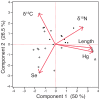Contrasting food web factor and body size relationships with Hg and Se concentrations in marine biota
- PMID: 24019976
- PMCID: PMC3760827
- DOI: 10.1371/journal.pone.0074695
Contrasting food web factor and body size relationships with Hg and Se concentrations in marine biota
Abstract
Marine fish and shellfish are primary sources of human exposure to mercury, a potentially toxic metal, and selenium, an essential element that may protect against mercury bioaccumulation and toxicity. Yet we lack a thorough understanding of Hg and Se patterns in common marine taxa, particularly those that are commercially important, and how food web and body size factors differ in their influence on Hg and Se patterns. We compared Hg and Se content among marine fish and invertebrate taxa collected from Long Island, NY, and examined associations between Hg, Se, body length, trophic level (measured by δ(15)N) and degree of pelagic feeding (measured by δ(13)C). Finfish, particularly shark, had high Hg content whereas bivalves generally had high Se content. Both taxonomic differences and variability were larger for Hg than Se, and Hg content explained most of the variation in Hg:Se molar ratios among taxa. Finally, Hg was more strongly associated with length and trophic level across taxa than Se, consistent with a greater degree of Hg bioaccumulation in the body over time, and biomagnification through the food web, respectively. Overall, our findings indicate distinct taxonomic and ecological Hg and Se patterns in commercially important marine biota, and these patterns have nutritional and toxicological implications for seafood-consuming wildlife and humans.
Conflict of interest statement
Figures




Similar articles
-
The relationships between mercury and selenium in plankton and fish from a tropical food web.Environ Sci Pollut Res Int. 2009 Jan;16(1):10-24. doi: 10.1007/s11356-008-0038-8. Epub 2008 Aug 27. Environ Sci Pollut Res Int. 2009. PMID: 18751748
-
Effect of diet, location and sampling year on bioaccumulation of mercury, selenium and cadmium in pelagic feeding seabirds in Svalbard.Chemosphere. 2015 Mar;122:14-22. doi: 10.1016/j.chemosphere.2014.10.060. Epub 2014 Nov 28. Chemosphere. 2015. PMID: 25441931
-
Mercury and selenium in tropical marine plankton and their trophic successors.Chemosphere. 2014 Sep;111:32-9. doi: 10.1016/j.chemosphere.2014.03.003. Epub 2014 Apr 19. Chemosphere. 2014. PMID: 24997897
-
Drivers of biomagnification of Hg, As and Se in aquatic food webs: A review.Environ Res. 2022 Mar;204(Pt C):112226. doi: 10.1016/j.envres.2021.112226. Epub 2021 Oct 27. Environ Res. 2022. PMID: 34717950 Review.
-
Selenium-mercury interactions and relationship to aquatic toxicity: a review.Integr Environ Assess Manag. 2025 Jan 1;21(1):70-78. doi: 10.1002/ieam.4918. Integr Environ Assess Manag. 2025. PMID: 38578152 Review.
Cited by
-
A synthesis of patterns of environmental mercury inputs, exposure and effects in New York State.Ecotoxicology. 2020 Dec;29(10):1565-1589. doi: 10.1007/s10646-020-02291-4. Epub 2020 Nov 10. Ecotoxicology. 2020. PMID: 33170395 Free PMC article.
-
Levels of Mercury, Methylmercury and Selenium in Fish: Insights into Children Food Safety.Toxics. 2021 Feb 20;9(2):39. doi: 10.3390/toxics9020039. Toxics. 2021. PMID: 33672494 Free PMC article.
-
Relationship of mercury and selenium in ocean fish frequently consumed in the Seychelles: A comparison to levels in ocean fish consumed in the US.Neurotoxicology. 2023 Dec;99:34-42. doi: 10.1016/j.neuro.2023.09.001. Epub 2023 Sep 5. Neurotoxicology. 2023. PMID: 37678724 Free PMC article.
-
Metals in Ten Commercial Demersal Fish from the East China Sea: Contribution to Aquatic Products Nutrition and Toxic Risk Assessment.Biol Trace Elem Res. 2022 Dec;200(12):5242-5250. doi: 10.1007/s12011-021-03087-1. Epub 2022 Jan 7. Biol Trace Elem Res. 2022. PMID: 34997533
-
Mercury concentrations in Baja California Sur fish: Dietary exposure assessment.Chemosphere. 2021 Mar;267:129233. doi: 10.1016/j.chemosphere.2020.129233. Epub 2020 Dec 7. Chemosphere. 2021. PMID: 33359982 Free PMC article.
References
-
- U.S. Food and Drug Administration and U.S. Environmental Protection Agency (2004) What You Need to Know About Mercury in Fish and Shellfish: Advice For Women Who Might Become Pregnant, Women Who are Pregnant, Nursing Mothers, Young Children. Available: http://www.fda.gov/Food/FoodborneIllnessContaminants/BuyStoreServeSafeFo.... Accessed April 2 2013.
-
- Price NM, Thompson PA, Harrison PJ (1987) Selenium - an Essential Element for Growth of the Coastal Marine Diatom Thalassiosira-Pseudonana (Bacillariophyceae). Journal of Phycology 23: 1–9.
-
- Underwood EJ (1977) Trace Elements in Human and Animal Nutrition. New York: Academic Press. 545.
-
- Magg DD, Glen MW (1967) Toxicity of selenium: farm animals. In: Muth OH, Oldfield JE, Heswig PH, Selenium in Biomedicine. Connecticut: AVI. 127–140.
-
- Hamilton SJ (2004) Review of selenium toxicity in the aquatic food chain. Science of the Total Environment 326: 1–31. - PubMed
Publication types
MeSH terms
Substances
LinkOut - more resources
Full Text Sources
Other Literature Sources
Medical

